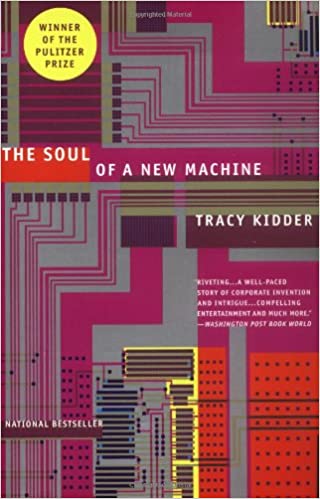I was scanning through the table of contents of the January 2021 issue of Communications of the ACM (Association for Computing Machinery), and an article title caught my eye: Historical Reflections The Immortal Soul of an Old Machine. Something about the title resonated in my mind. When I flipped to it, I recognized what the trigger for that sense of familiarity was. The article is an analysis not of the soul of an old machine, but of the book by Tracy Kidder, “The Soul of a New Machine.”
I highly recommend reading the article as well as the book it’s based around. The author of the article, Thomas Haigh, does a great job analyzing how Tracy Kidder’s book came to be so successful. As Haigh writes, it is “The best book ever written about IT work or the computer industry….” That’s quite a claim. Haigh only casually justifies that specific assertion. However, he does an excellent job describing what made the book a success when it was issued in 2000 (winning a Pulitzer prize) and why it is still a success. At this writing, Amazon shows it to be #11 in Computing Industry History. Go get the book.
When I read Kidder’s book, I worked in the computer industry and was delighted by the book’s story. The part of the business I worked in was a US defense corporation, so that world was different, yet still much the same, as the cutthroat commercial world Data General existed in. My work experience is covered by an impenetrable layer of NDAs, so I’m not going to say anything specific about That. Nonetheless, there are great connections between what Haigh thought made the book work, the experience of working as an engineer, and the experience of writing a fictional story and trying to make *that* work.
I’ve always maintained that personal reputation was the most precious commodity an engineer had. Can you get things done? Can people trust your judgment when you say something can be done or can’t be done? Managers and customers don’t understand the problem you are working on. Although you can and must provide persuasive technical arguments for your judgments to other technical specialists, you will often find yourself in a place where you are alone on the island. No one else has gone where you are, and they simply can’t tell if you’re right or you’re wrong. So, they look at your past.
Haigh describes that the hero of the story, Tom West, “…rounded up the best of the engineers left behind in Massachusetts to launch a semi-clandestine effort….” How did he know who was the best? Reviewing the personnel files in HR? I doubt it. My experience is that you know people who’ve succeeded on projects with you in the past, and you know people who know people…. That system works well; however, it can be a profound and invisible barrier for new employees to get over. It’s easy to imagine personal attributes that should have nothing to do with job performance lifting people over that barrier or holding them back. I know exactly whom I would go to if I needed someone to make a technical pitch to a customer’s management. I also know exactly whom I would go to if I needed a software designer for deep-down low-level code that has its hands deep into the bowels of the individual bits and bytes of a piece of hardware. How does a new person break into that circle? I think it’s by impressing existing experts with their competence. Then the word will get around. As simple as that sounds, there are significant dangers that a person can become miscast or overlooked.
In writing a story, the author has a similar problem. Who do you want to take with you on the journey of this story? How can I construct these “people” so that the reader becomes invested in their fate and believes in their actions? Two of the attributes that Haigh believes that Kidder incorporated into his book were rooting for the underdog and understanding the technology by caring about the people. Rooting for the underdog is a natural draw for readers and viewers (think about stories like Rocky, The Karate Kid, The Martian…). The protagonist(s) of Bound are skilled, powerful warriors. They are hardly underdogs. How do I make them appealing to readers? Did I make them appealing to readers? One of the things I attempted to do was to give them vulnerabilities and failures that readers could understand and could fear might happen again in the future. Did I succeed? You’ll have to tell me what you think.

